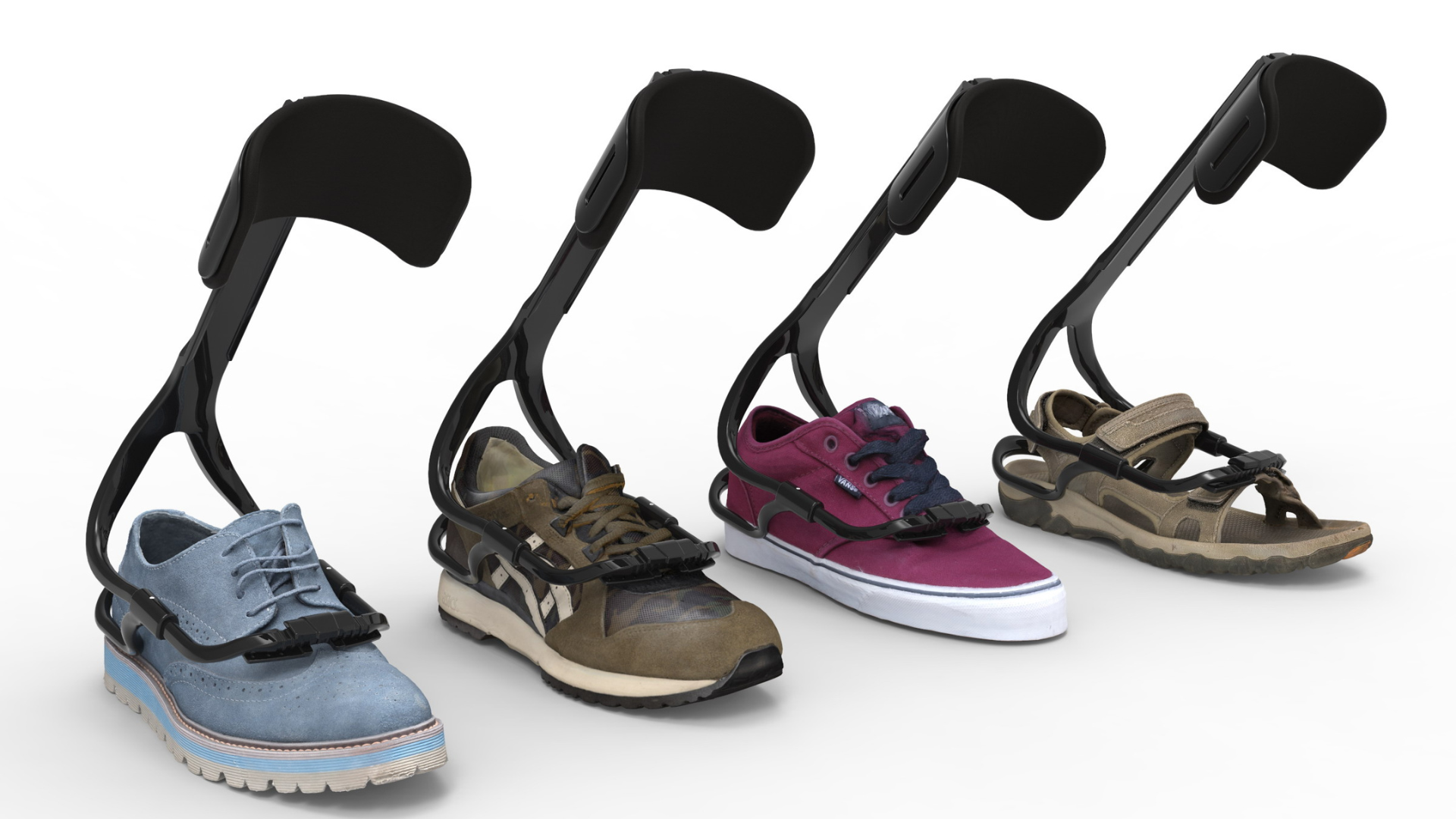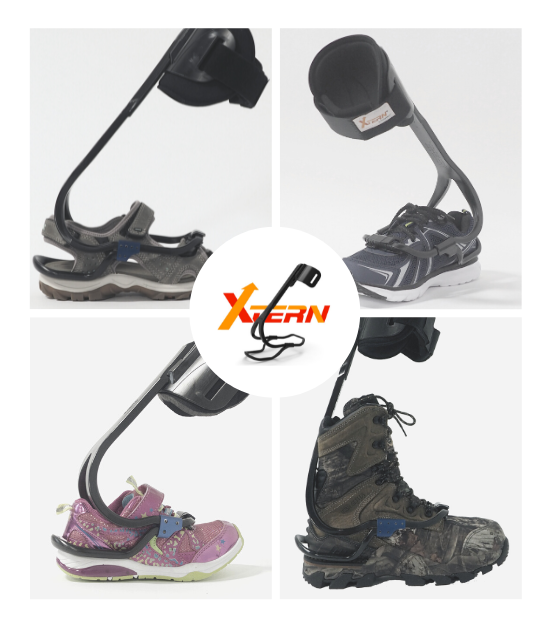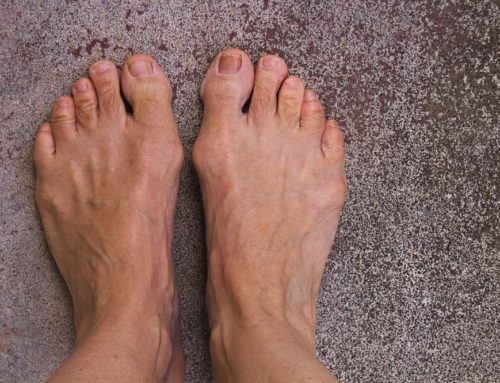Foot drop (also known as dropped foot) is a condition that can impact individuals with various types of injuries. Foot drop is caused by weakness in the muscles on the front of the lower leg, which help to clear the foot during walking. This can lead to tripping and falling.
Ankle foot orthoses (AFOs) are devices worn to help keep the foot in a neutral position when walking, which helps the foot to clear during the swing phase of gait. There are several types of AFOs that can be custom-made to fit the individual. An assessment by an experienced physiotherapist can help determine whether an AFO is right for you.
This article will describe foot drop, and discuss common foot drop causes and treatment, including several types of ankle foot orthoses. We will also introduce the Turbomed XTERN AFO and discuss how it can be used in individuals with foot drop.
Table of Contents:
- What is foot drop?
- Foot drop causes
- Foot drop treatment
- What is an ankle-foot orthosis?
- New Xtern Turbomed external AFO
- How can physiotherapy help
What is Foot Drop?
Foot drop is a condition that is characterized by weakness in the muscles in the front of the lower leg. This impacts the ability to flex your foot up, otherwise known as dorsiflexion. When individuals with foot drop are walking, they have difficulty clearing their toes when swinging their foot forward, which often leads to tripping and falling.
Foot Drop Causes
One of the main muscles in your leg that contributes to the dorsiflexion motion of flexing your foot up when you walk is called the tibialis anterior. This muscle receives its innervation from the peroneal nerve, which can be found running down the outside of the lower leg.
Nerve damage caused by a spinal cord injury, damage within the brain (such as a stroke or brain injury), or compression of the nerve supplying the muscles that dorsiflex the foot can lead to foot drop.
Excessive tightness or tone) in the muscles of the calf after brain injury, stroke, spinal cord injury, multiple sclerosis or other neurological conditions, can further lead to the development and progression of foot drop.
Foot Drop Treatment
Treatment for foot drop depends on the cause. If the cause is successfully treated, there is a good chance that the condition might improve or even resolve completely. However, if the root cause cannot be treated, foot drop can be permanent.
Treatment for foot drop might include:
Braces or splints: One effective method is to utilize a custom-designed brace on your ankle and foot (called an ankle-foot orthoses or AFO) or splint that fits into your shoe. These aids can help hold your foot in a normal position to facilitate walking.
Physical therapy: A physiotherapist with experience in treating neurological injuries and conditions can develop a tailored exercise program aimed at strengthening your leg muscles, which in turn, may lead to improvements in gait problems associated with foot drop. Stretching exercises, in particular, play an important role in preventing the stiffness in the calf and heel.
Nerve stimulation: Sometimes stimulating the nerve that lifts the foot improves foot drop. Stimulation is given to the muscles at the front of the leg. A switch worn in the shoe triggers the stimulation and electrical signals reach the muscles through electrodes placed on the skin on the side of the leg, just below the knee.
At Propel Physiotherapy, we use the Odstock ODFS® Pace from Odstock Medical Ltd. which is distributed in Canada through FES Mobility. The ODFS® Pace is a versatile FES device that can be used for a variety of functional tasks (foot drop, gait training, strength training, sit to stand). For more information on the Odstock ODFS® Pace and Pace XL visit fesmobility.com.
We also have extensive experience and training using Bioness® systems including the L300 Foot Drop System and the The H200 Wireless Hand Rehabilitation System.
Surgery: Nerve surgery might be helpful depending on the cause and how long the condition has persisted. If foot drop is long-standing, your doctor might suggest surgery that transfers a working tendon to a different part of the foot to improve function.
What is an Ankle-Foot Orthosis?
Ankle-foot orthosis, also known as AFOs, are devices commonly used for people living with foot drop. An AFO supports the foot and ankle during walking by helping to maintain proper alignment and stability and preventing the toes from pointing down.
This is important as it helps to clear your toes when swinging your foot through during gait and prevents you from catching your toes and tripping. It also helps to provide good heel contact when the foot comes in contact with the ground.
Common Ankle-Foot Orthoses for Foot Drop:
- Solid Ankle AFO: These types of AFOs are custom made by an orthotist. A solid AFO does not allow any movement at the ankle and is rigid in its design (left top image). Another type of solid AFO has a spring in it, to allow for minimal amounts of dorsiflexion (right top image).
- Hinged AFO: These types of AFOs (bottom 2 images) are used when ankle movement is allowed, but you want to limit the amount. In this case, a certain amount of dorsiflexion is permitted to make it easier to walk and climb stairs. These require you to have good knee control and stability within the ankle.
New Turbomed XTERN Foot Drop Brace
Turbomed XTERN is an AFO that can be used for people experiencing foot drop. This newly developed modular AFO with a sleek design can be used for a variety of daily activities. Compared to plastic orthoses, the XTERN is made from durable thermoplastic and can be attached to almost any shoe.
Benefits of the Turbomed XTERN AFO:
- Unlike other plastic AFOs that sit inside a shoe, the XTERN attaches to the outside of your shoe, preventing skin breakdown and rubbing.
- It can allow for walking, running, hiking and many other activities. The XTERN can be placed on many different types of shoes, allowing for it to be easily switched from one type of footwear to another.
- There are different sizes of the Turbomed XTERN to ensure you get the right fit for your shoe size. Your physiotherapist will measure your shoes and order the correct size. When the AFO is received, your physiotherapist will ensure that it is fitted correctly for your shoes and teach you how to take it on and off.
- Due to the unique patented design of the Turbomed XTERN, there is a spring-like action that stores energy, allowing for your foot to clear more easily during walking. This can help to increase activity endurance, decrease fatigue, and reduce the risk of tripping and falling.
Below are photos showing the Turbomed during a variety of different shoe types:
Client Characteristics for Optimal Benefits
In order to be a good candidate for using the Turbomed EXTERN AFO, there are some factors that need to be considered:
- Adequate strength of your plantarflexor muscles – these muscles help you to push your foot off the ground during gait.
- Good knee control and hip stability – these joints need good stability while walking with XTERN as this AFO does not offer any support to the knee and hip.
- Adequate balance and strength to walk with or without a gait aid. A walker or a cane can be used in conjunction with the Turbomed for greater stability.
Comparison: No AFO versus the Turbomed XTERN
In the before video, the client is walking with no AFO. On the individual’s right side, the toes are pointed down and inwards due to muscle weakness in the dorsiflexor and evertor muscles as they swing their foot through. There is decreased heel contact as the individual steps down onto their right foot, as well as hyperextension through the knee as they put weight on the right side.
In the after video, the client is walking with the Turbomed XTERN AFO. The AFO is fixated to their shoe and wraps around their calf. When walking during this video, the individual’s right foot is better able to clear the ground when swinging during gait, and they have better control of their ankle movements. Additionally, the individual exhibits better alignment at the trunk and improved arm swing, and improved balance when using the XTERN device, with decreased reliance on his gait aid.
How Can Propel Physiotherapy Help?
At Propel Physiotherapy, we understand how important an AFO can be to your overall recovery and well-being. We will complete a detailed gait assessment to determine if the Turbomed XTERN AFO is a good option for you. We help you to determine the correct sizing, teach you how to put it on and take it off properly, and work with you during treatment sessions to practice walking and completing other activities safely, to help you achieve your rehabilitation goals.
References
Choo, Y. J., & Chang, M. C. (2021). Commonly Used Types and Recent Development of Ankle-Foot Orthosis: A Narrative Review. Healthcare (Basel), 9(8), 1046–. https://doi.org/10.3390/healthcare9081046
Stewart JD. Foot drop: where, why and what to do? Practical neurology. 2008;8(3):158–69.
Turbomed XTERN – External ankle foot orthosis (AFO). (n.d.). Turbomed Orthotics – the Most Advanced Foot Drop Brace. https://turbomedorthotics.com/en/products/turbomed-xtern-external-ankle-foot-orthosis
Written by













